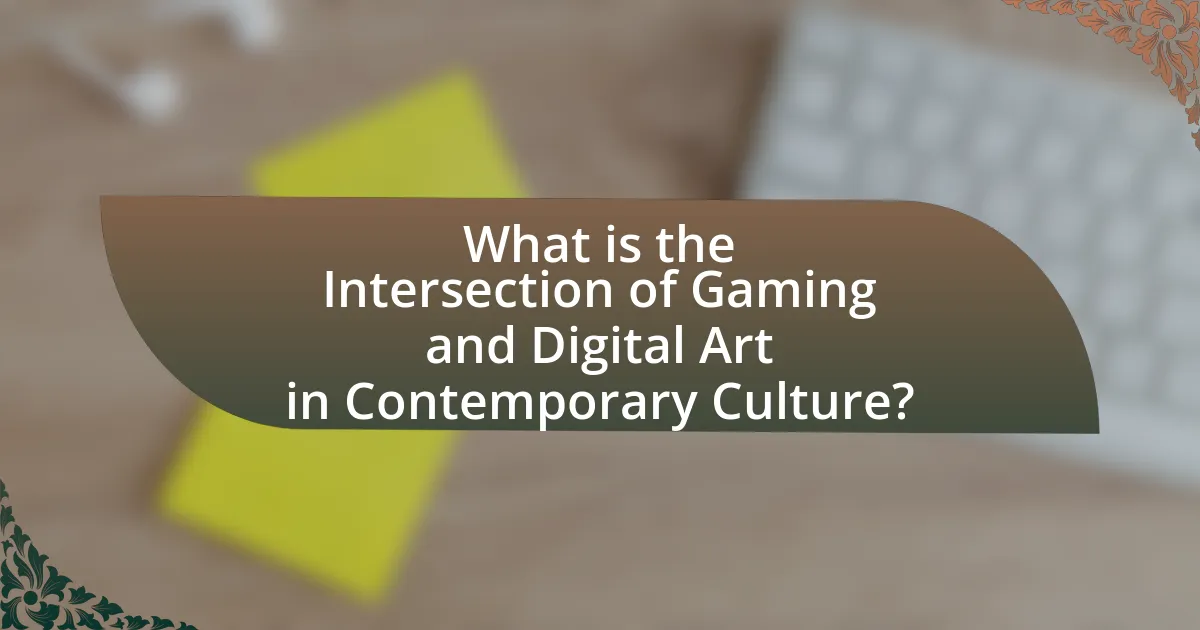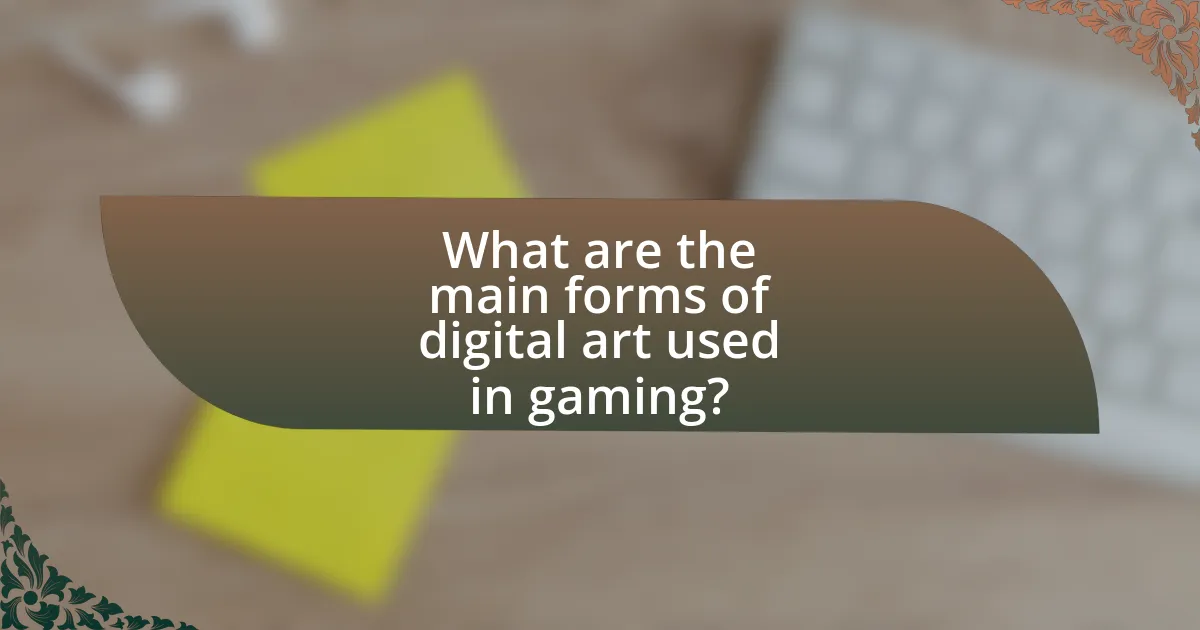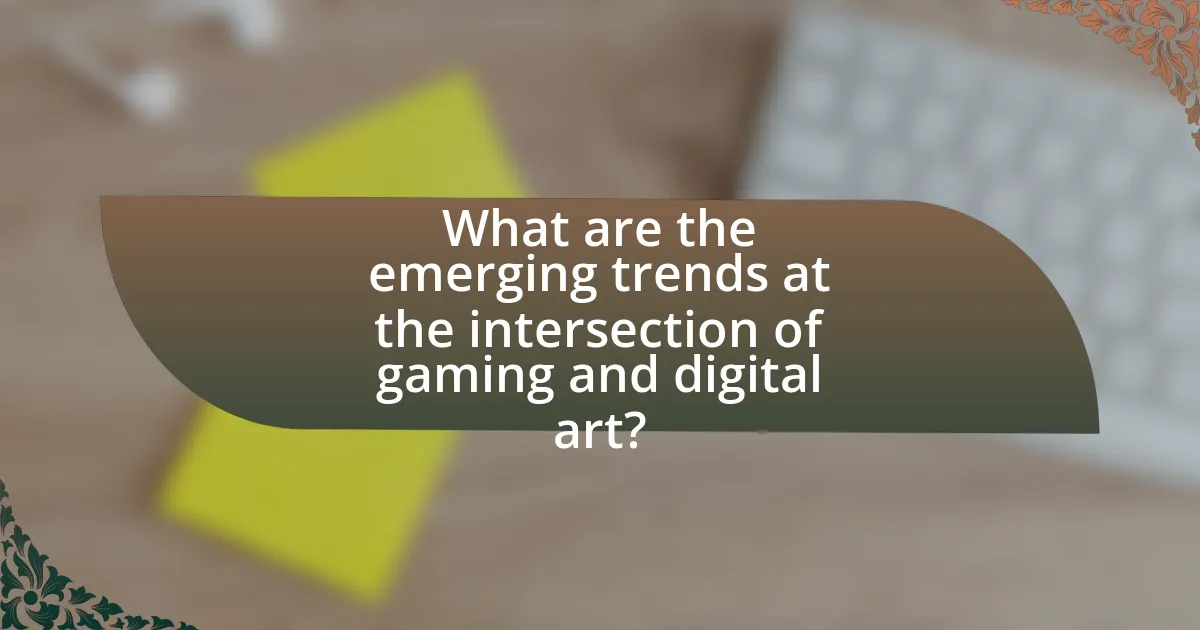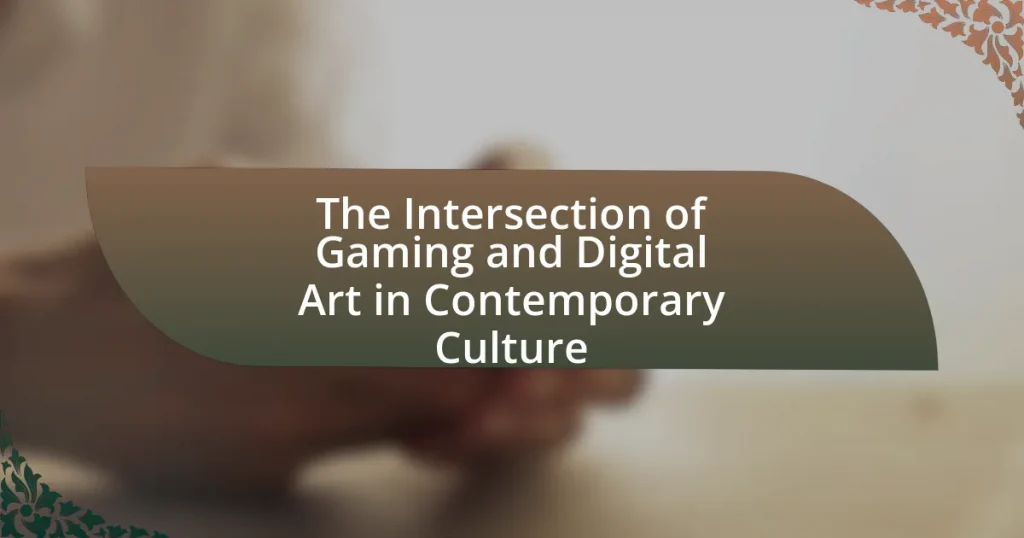The intersection of gaming and digital art in contemporary culture represents a significant fusion of artistic expression and interactive media. This article explores how digital art enhances gaming experiences through elements such as character design, environment art, and animation, while also examining the reciprocal influence between the two fields. Key trends, including the rise of user-generated content, virtual reality, and community engagement, are discussed, highlighting their impact on artistic innovation and cultural relevance. Additionally, the article addresses the evolving role of digital art in shaping modern storytelling and the broader societal values reflected in this convergence.

What is the Intersection of Gaming and Digital Art in Contemporary Culture?
The intersection of gaming and digital art in contemporary culture is characterized by the integration of artistic expression within interactive digital environments. This fusion allows artists to create immersive experiences that engage players not only through gameplay but also through visual storytelling and aesthetic design. For instance, games like “Journey” and “Gris” exemplify how visual art influences gameplay mechanics and emotional narratives, showcasing the potential of digital art to enhance player experience. Furthermore, the rise of platforms like ArtStation and DeviantArt highlights the growing recognition of game art as a legitimate form of artistic expression, with many artists gaining visibility and opportunities within the gaming industry. This convergence reflects a broader cultural shift where digital art is increasingly valued in both the gaming community and the art world, demonstrating the significant role that interactive media plays in contemporary artistic practices.
How do gaming and digital art influence each other?
Gaming and digital art influence each other through the integration of artistic design in game development and the use of gaming elements in digital art. Game developers rely on digital art to create immersive environments, character designs, and visual storytelling, which enhances player engagement and experience. Conversely, digital artists often draw inspiration from gaming aesthetics, incorporating interactive elements and game mechanics into their artwork, thus expanding the boundaries of traditional art forms. This reciprocal relationship is evident in the rise of art games and exhibitions that showcase interactive digital art, demonstrating how both fields evolve together and influence contemporary culture.
What are the key elements of gaming that incorporate digital art?
The key elements of gaming that incorporate digital art include character design, environment art, user interface design, and animation. Character design involves creating visually appealing and unique characters that resonate with players, often utilizing techniques from digital illustration and 3D modeling. Environment art focuses on crafting immersive worlds, employing textures, lighting, and spatial design to enhance the gaming experience. User interface design integrates digital art to create intuitive menus and HUDs, ensuring seamless interaction. Animation brings characters and environments to life, utilizing principles of motion and timing to create engaging gameplay. These elements collectively enhance the aesthetic and functional aspects of games, making digital art an integral part of the gaming industry.
How does digital art enhance the gaming experience?
Digital art enhances the gaming experience by creating immersive environments and visually engaging characters that captivate players. High-quality digital art contributes to storytelling by establishing mood and atmosphere, which can significantly affect player emotions and engagement. For instance, games like “The Legend of Zelda: Breath of the Wild” utilize stunning landscapes and intricate character designs to draw players into their world, enhancing overall enjoyment and investment in the narrative. Additionally, research indicates that visually appealing graphics can improve player satisfaction and retention, as seen in studies conducted by the International Journal of Human-Computer Interaction, which highlight the correlation between visual aesthetics and user experience in gaming.
Why is the intersection significant in contemporary culture?
The intersection of gaming and digital art is significant in contemporary culture because it represents a fusion of creativity and technology that shapes modern storytelling and artistic expression. This convergence allows artists to explore interactive narratives and immersive experiences, enhancing audience engagement. For instance, the rise of video games as a legitimate art form has been recognized by institutions like the Smithsonian American Art Museum, which hosted the “The Art of Video Games” exhibition in 2012, showcasing the artistic merit of gaming. Furthermore, platforms like Twitch and YouTube have enabled artists and gamers to share their work and connect with global audiences, further solidifying the cultural impact of this intersection.
What cultural shifts have occurred due to the merging of gaming and digital art?
The merging of gaming and digital art has led to significant cultural shifts, particularly in the realms of artistic expression and community engagement. This integration has transformed video games into a recognized art form, with events like the Smithsonian American Art Museum’s “The Art of Video Games” exhibition in 2012 showcasing games as a medium for artistic storytelling and visual innovation. Additionally, platforms such as ArtStation and DeviantArt have emerged, allowing artists to share and monetize their work, fostering a community where digital art inspired by gaming thrives. This shift has also influenced mainstream culture, as seen in collaborations between game developers and traditional artists, which blur the lines between gaming and fine art, further legitimizing digital art in cultural discourse.
How does this intersection reflect societal values and trends?
The intersection of gaming and digital art reflects contemporary societal values and trends by showcasing the increasing acceptance and integration of technology in creative expression. This convergence highlights a shift towards valuing interactive experiences and community engagement, as evidenced by the rise of platforms like Twitch and Discord, where gamers and artists collaborate and share their work. Furthermore, the growing popularity of virtual reality and augmented reality in both gaming and digital art signifies a societal trend towards immersive experiences, emphasizing the importance of innovation and adaptability in cultural consumption. This evolution is supported by statistics indicating that the global gaming market is projected to reach $200 billion by 2023, illustrating the significant economic impact and cultural relevance of this intersection.

What are the main forms of digital art used in gaming?
The main forms of digital art used in gaming include 2D art, 3D modeling, animation, and visual effects. 2D art is utilized for character design, backgrounds, and user interfaces, while 3D modeling creates the game’s environments and characters, allowing for immersive experiences. Animation brings these models to life through movement, and visual effects enhance the overall aesthetic by adding elements like explosions or weather effects. These forms are essential in creating engaging and visually appealing games, as evidenced by the success of titles like “The Legend of Zelda: Breath of the Wild,” which combines these art forms to create a rich gaming experience.
What types of digital art are prevalent in the gaming industry?
The prevalent types of digital art in the gaming industry include concept art, 3D modeling, texture art, and user interface design. Concept art serves as the foundational visual representation of characters, environments, and assets, guiding the overall aesthetic of a game. 3D modeling involves creating three-dimensional representations of characters and environments, which are essential for modern gaming graphics. Texture art enhances these models by adding surface details and realism, while user interface design focuses on the visual layout and interactive elements that players engage with during gameplay. These forms of digital art are integral to the gaming experience, as they contribute to storytelling, immersion, and player interaction.
How do 2D and 3D art styles differ in their application to games?
2D and 3D art styles differ significantly in their application to games primarily through their visual representation and interaction mechanics. 2D art styles utilize flat images and sprites, which create a distinct aesthetic often associated with retro or indie games, allowing for simpler animations and easier asset management. In contrast, 3D art styles involve three-dimensional models that provide depth and realism, enabling more complex environments and character interactions, as seen in AAA titles. The choice between these styles impacts gameplay experience; for instance, 2D games often focus on platforming and puzzle-solving, while 3D games can incorporate immersive exploration and realistic physics. This distinction is evident in the success of games like “Celeste,” which employs 2D graphics for a focused gameplay experience, versus “The Legend of Zelda: Breath of the Wild,” which leverages 3D art to create an expansive open world.
What role does animation play in digital art for gaming?
Animation is essential in digital art for gaming as it brings characters and environments to life, enhancing player engagement and immersion. Through techniques such as frame-by-frame animation and skeletal animation, developers create dynamic movements that convey emotions and actions, making gameplay more interactive. For instance, animated cutscenes and character animations can significantly influence storytelling and player experience, as seen in games like “The Last of Us,” where animation contributes to emotional depth. Furthermore, the integration of animation in user interfaces and gameplay mechanics is crucial for providing feedback and guiding players, thereby improving overall usability and enjoyment.
How do artists create immersive environments in games?
Artists create immersive environments in games by utilizing advanced techniques in visual design, sound, and interactivity. They employ detailed textures, realistic lighting, and atmospheric effects to enhance the visual fidelity of game worlds, making them feel more lifelike and engaging. For instance, the use of dynamic weather systems and day-night cycles can significantly alter the player’s experience, creating a sense of realism and immersion. Additionally, sound design plays a crucial role; ambient sounds and spatial audio contribute to the overall atmosphere, allowing players to feel as though they are truly part of the environment. Research indicates that environments designed with player agency in mind, such as interactive elements and branching narratives, further enhance immersion by allowing players to influence their surroundings and experiences.
What techniques are used to design realistic game worlds?
Techniques used to design realistic game worlds include procedural generation, photogrammetry, and advanced lighting systems. Procedural generation allows developers to create vast, diverse environments algorithmically, enhancing scalability and variety. Photogrammetry involves capturing real-world objects and environments through photographs to create highly detailed 3D models, which increases realism. Advanced lighting systems, such as ray tracing, simulate how light interacts with surfaces, producing lifelike shadows and reflections. These techniques collectively contribute to immersive experiences, as evidenced by games like “The Legend of Zelda: Breath of the Wild,” which utilizes procedural generation for its expansive landscapes, and “Cyberpunk 2077,” which employs photogrammetry and ray tracing for its urban environments.
How do lighting and color theory impact player experience?
Lighting and color theory significantly impact player experience by influencing mood, immersion, and gameplay dynamics. Effective use of lighting can create tension or calmness, guiding players’ emotional responses and enhancing narrative elements. For instance, studies show that warm colors can evoke feelings of comfort, while cooler tones may induce a sense of unease. Additionally, dynamic lighting can affect visibility and gameplay mechanics, as seen in games like “Dead Space,” where shadows create suspense and challenge. Color theory also plays a crucial role in visual hierarchy, helping players navigate environments and understand game objectives. Research indicates that color contrast can improve readability and focus, ultimately enhancing user engagement and satisfaction.

What are the emerging trends at the intersection of gaming and digital art?
Emerging trends at the intersection of gaming and digital art include the rise of interactive installations, the integration of virtual reality (VR) and augmented reality (AR), and the use of blockchain technology for digital ownership. Interactive installations are becoming more prevalent as artists create immersive experiences that engage players in new ways, blurring the lines between gameplay and artistic expression. The integration of VR and AR allows for more dynamic and engaging environments, enabling artists to create expansive worlds that players can explore. Additionally, blockchain technology is facilitating the creation and sale of non-fungible tokens (NFTs), which provide a way for digital artists to establish ownership and provenance of their work, thus transforming the economics of digital art in gaming. These trends reflect a growing synergy between the two fields, fostering innovation and new forms of creative expression.
How is virtual reality changing the landscape of digital art in gaming?
Virtual reality is transforming the landscape of digital art in gaming by enabling immersive experiences that allow artists to create and interact with their work in three-dimensional spaces. This technology facilitates a new level of engagement, where players can not only observe but also participate in the artistic process, leading to dynamic and evolving art forms. For instance, platforms like Tilt Brush allow users to paint in a virtual environment, resulting in unique, spatial artworks that can be experienced from multiple angles. Additionally, VR art installations in games like “Half-Life: Alyx” showcase how digital art can enhance storytelling and emotional impact, demonstrating the potential for deeper connections between players and the art within the game.
What innovations are being introduced in VR gaming art?
Innovations in VR gaming art include the integration of real-time rendering techniques, enhanced interactivity through haptic feedback, and the use of artificial intelligence for dynamic content generation. Real-time rendering allows for more immersive environments that respond instantly to player actions, significantly enhancing the visual experience. Haptic feedback technology provides tactile sensations that correspond with in-game actions, creating a deeper emotional connection to the virtual world. Additionally, AI-driven content generation enables the creation of unique art assets and environments tailored to individual player experiences, making each gameplay session distinct. These advancements are reshaping the landscape of VR gaming art, pushing the boundaries of creativity and player engagement.
How do user-generated content and modding influence digital art in games?
User-generated content and modding significantly enhance digital art in games by allowing players to create, modify, and share their artistic expressions within game environments. This participatory approach fosters a diverse range of artistic styles and innovations, as seen in popular games like “Minecraft” and “The Sims,” where players have produced millions of custom skins, textures, and mods. Research indicates that user-generated content not only extends the lifespan of games but also cultivates a vibrant community of artists, as evidenced by the success of platforms like Nexus Mods, which hosts over 1.5 million mods for various games. This collaborative environment encourages experimentation and creativity, ultimately enriching the overall aesthetic and cultural value of digital art in gaming.
What role does community play in the evolution of gaming and digital art?
Community plays a crucial role in the evolution of gaming and digital art by fostering collaboration, creativity, and feedback among creators and players. This interaction leads to the development of innovative ideas and artistic expressions, as seen in platforms like Twitch and Discord, where gamers and artists share their work and experiences. For instance, the rise of user-generated content in games such as Fortnite and Minecraft demonstrates how community engagement drives the evolution of game design and digital art styles. Additionally, community-driven events like game jams and art contests encourage participation and experimentation, further shaping the landscape of both fields.
How do online platforms facilitate collaboration between gamers and artists?
Online platforms facilitate collaboration between gamers and artists by providing accessible tools and communities for interaction and project development. These platforms, such as Discord, ArtStation, and Twitch, enable real-time communication, allowing artists to showcase their work and receive immediate feedback from gamers. Additionally, platforms like Kickstarter and Patreon allow artists to fund their projects through gamer support, creating a direct economic link between the two groups. The integration of user-generated content in games, such as mods and skins, further exemplifies this collaboration, as artists can contribute their designs directly to gaming experiences, enhancing both the artistic and gaming communities.
What impact does fan art have on the gaming industry?
Fan art significantly impacts the gaming industry by fostering community engagement and enhancing brand loyalty. It allows fans to express their creativity and emotional connection to games, which can lead to increased visibility and interest in the original titles. For instance, popular games like “Overwatch” and “The Legend of Zelda” have thriving fan art communities that contribute to their cultural relevance and longevity. Additionally, fan art can serve as a form of free marketing, as it often circulates widely on social media platforms, attracting new players. Studies have shown that user-generated content, including fan art, can positively influence purchasing decisions, with 79% of consumers indicating that user-generated content highly impacts their buying behavior. Thus, fan art not only enriches the gaming experience but also plays a crucial role in the commercial success of gaming franchises.
What practical tips can artists and gamers use to navigate this intersection?
Artists and gamers can navigate the intersection of gaming and digital art by collaborating on projects that blend both disciplines, utilizing platforms like Twitch and Discord for community engagement, and participating in game jams to foster creativity. Collaboration allows artists to contribute visual elements to games while gamers can provide feedback on gameplay experiences, enhancing both art and gaming. Engaging with communities on platforms like Twitch and Discord helps in networking and gaining insights into audience preferences, which can inform artistic direction. Game jams, which are time-constrained events where participants create games, encourage experimentation and innovation, allowing artists and gamers to explore new ideas and techniques together. These strategies are supported by the growing trend of indie games that emphasize artistic expression, as seen in titles like “Journey” and “Gris,” which showcase the successful fusion of art and gameplay.




